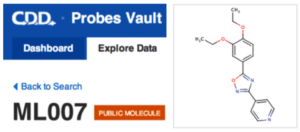Making the NIH Chemical Probes (over half a billion dollars of NIH investment) accessible in CDD Public
The Molecular Libraries Program (MLP) has been a tremendous resource for academic labs to pursue the development of chemical probes in a wide range of biological processes. The National Institutes of Health (NIH) has funded extensive HTS efforts, by conservative estimates over half a billion dollars has gone into the program, and we wanted to make mining the valuable fruits of this research as easy and widely available as possible.
So we owe a huge debt of appreciation to Dr. Christopher Lipinski for working with us to gather information on all the current, in excess of 300, NIH molecular probes. We have now shared this data set through CDD’s free public access repository CDD Public. CDD Vault users can now not only readily find these molecules as a single dataset but also mine this data alongside their own private data sets, as well as hundreds of other public data sets that are already available. In addition, with CDD Vision, this data can be used to build predictive machine learning models.
For compounds to be elected as probes, they must meet a number of criteria, based on a combination of potency, selectivity, solubility, and availability, and represent a significant improvement from what is currently available. The goal for the NIH molecular probes was to create tools for dissecting molecular and cellular functions in order to gain understanding into biological processes and diseases. The wide-range of biological processes explored through the project is quite impressive. Both phenotypic and enzymatic assays were employed to identify anti-infectives for parasites, molecular chaperones for protein misfolding disorders, ion channel and receptor modulators for neurological disease, and many more.
With the right properties, probes can also go on to become valuable therapeutics for treating disease. In an exciting development, a probe has been further improved by Receptos Inc and yielded a drug candidate that is being tested in humans in a Phase I clinical trial. The original probe (ML007) was developed by the Scripps Research Institute to target the sphingosine-1-phosphate receptor 1 (S1P1), a G-protein coupled receptor involved in regulation of the immune system. Receptos Inc hopes that this may lead to a new treatment for multiple sclerosis, a devastating auto-immune, neurodegenerative disorder.
As the probes program matures, it will be interesting to learn from these research efforts and fully understand the unique impact of each project toward understanding biology and for therapeutic development.
Watch this space for future posts on this dataset!
This blog is authored by members of the CDD Vault community. CDD Vault is a hosted drug discovery informatics platform that securely manages both private and external biological and chemical data. It provides core functionality including chemical registration, structure activity relationship, chemical inventory, and electronic lab notebook capabilities!
CDD Vault: Drug Discovery Informatics your whole project team will embrace!



